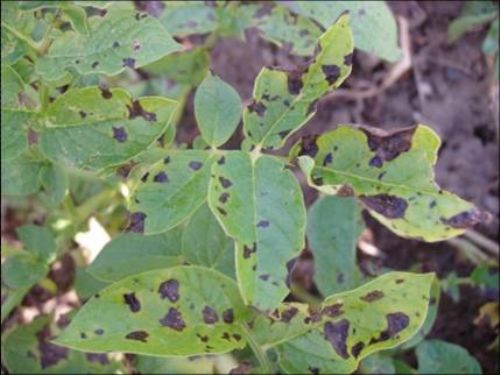
With the late blight becoming more aggressive and the threat of early blight (Alternaria) increasing, growers are turning to Dithane (mancozeb) as their fungicide of choice in potatoes as it has a full label recommendation for the control of both diseases.
"Already a widespread disease in potatoes in Europe, Alternaria has become much more of a problem in the UK. In fact some experts say that its increase is a direct result of less mancozeb being used in the whole programme. But in the UK Alternaria rarely appears alone; it’s usually found in conjunction with late blight (Phytophthora). If growers want to make sure their valuable potato crops are covered against both these blights, they need a fungicide with proven dual activity, such as Dithane," says Dr David Stormonth, Technical Manager for Interfarm.
He explains that the protectant fungicide mancozeb, as in Dithane NT and Dithane 945, is regarded as the key active against Alternaria on the Continent where this disease is much more significant and prevalent. "Dithane is one of the very few fungicides to have label recommendations for both diseases. In the UK there are only a few products with either label or SOLA approvals for Alternaria alone, but importantly Dithane now has full label recommendations for both early and late blight, following its re-registration. It is reassuring that the registration authorities are convinced of Dithane’s effectiveness against both blights and that the re-registered Dithanes have re-freshed labels, supported by up-to-date field data."
Rates of use for both products against late and early potato blight are 2kg/ha, delivering 1500 gms a.i/ha, which experts agree is the minimum effective dose for Alternaria activity. The spray interval is 7 days and the harvest interval is 7 days. The maximum number of applications is 8 per crop, which gives plenty of opportunity to use Dithane throughout the full programme, says David.
According to David Stormonth, Dithane remains a cost-effective protectant fungicide, widely used in potatoes, even after decades of use. "Unlike most other fungicides these days, Dithane is not affected by various regulatory or advisory guidelines to manage or prevent resistance occurring. It just gets on with the job. Mancozeb is the major multi-site fungicide and is the key element for resistance management in all late blight programmes, either as a straight or in co-formulation. Working on more than 6 different sites in the pathogen, there is no known resistance to mancozeb, which is why it is co-formulated into many blight fungicides. If you want reliable protection against either early or late blight, use Dithane".
"Advances in production and formulation technology have also led to a more modern formulation of Dithane compared to many look-alike offerings. The advanced formulation means better rainfastness, reduced dust and reduced operator risk. Product handling, shelf life properties and product effectiveness have all been significantly improved as a consequence," says David.
